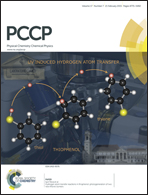Improved photoactivity of TiO2–Fe2O3 nanocomposites for visible-light water splitting after phosphate bridging and its mechanism†
Abstract
In this work, we have successfully constructed phosphate bridges in a TiO2–Fe2O3 nanocomposite using wet-chemical processes. Based on FTIR, XPS and TEM measurements it is confirmed that phosphate groups form bridges that effectively connect TiO2 and α-Fe2O3. From steady-state surface photovoltage spectra (SS-SPS) and transient-state surface photovoltage (TS-SPV) measurements in N2, it is clearly demonstrated that the separation and lifetime of the photogenerated charge carriers in the TiO2–Fe2O3 nanocomposite are greatly enhanced by the introduction of the phosphate bridges. As a consequence, the visible light photocatalytic activity in water reduction by methanol and the photoelectrochemical water oxidation were obviously improved after phosphate bridging. It is concluded mainly on the basis of ultra-low-temperature EPR signals, EIS spectra, and the normalized photocurrent action spectra that the photogenerated electrons of α-Fe2O3 under irradiation with visible light would transfer to TiO2 in the nanocomposite, and the built phosphate bridges are favorable for charge transportation, leading to the greatly-increased separation and lifetime of visible-light excited charge carriers. This work provides a feasible route to improve the photoactivity of other visible-response nanocomposites for water splitting.


 Please wait while we load your content...
Please wait while we load your content...